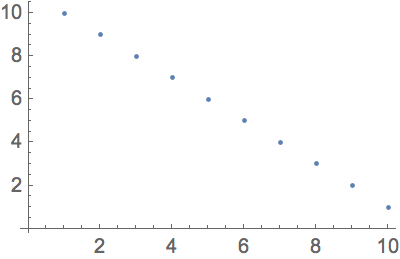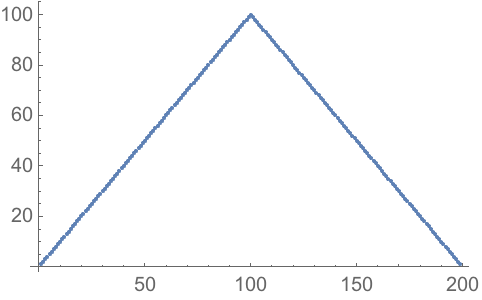Lists are a basic way to collect things together in the Wolfram Language. {1,2,3} is a list of numbers. On their own, lists don’t do anything; they’re just a way to store things. So if you give a list as input, it’ll just come back unchanged:
ListPlot is a function that makes a plot of a list of numbers.
Plot the list of numbers {1, 1, 2, 2, 3, 4, 4}:
Plot the list of numbers {10, 9, 8, 7, 3, 2, 1}:
Range is a function that makes a list of numbers.
Generate a list of numbers up to 10:
Generate a list of numbers, then plot it:
Reverse reverses the elements in a list.
Reverse the elements in a list:
Reverse what
Range has generated:
Plot the reversed list:
Join joins lists together, making a single list as the result.
Join lists together:
Join two lists made by
Range:
Plot three lists joined together:
Reverse the list in the middle:
| {1,2,3,4} | | list of elements |
| ListPlot[{1,2,3,4}] | | plot a list of numbers |
| Range[10] | | range of numbers |
| Reverse[{1,2,3}] | | reverse a list |
| Join[{4,5,6},{2,3,2}] | | join lists together |
3.1Use
Range to create the list
{1, 2, 3, 4}.
»
3.2Make a list of numbers up to 100.
»
3.4Make a list of numbers from 1 to 50 in reverse order.
»
3.6Plot a list that counts up from 1 to 100, then down to 1.
»
3.9Find a simpler form for
Join[{1, 2}, Join[{3, 4}, {5}]].
»
+3.1Compute the reverse of the reverse of
{1, 2, 3, 4}.
»
+3.3Use
Range,
Reverse and
Join to create
{3, 2, 1, 4, 3, 2, 1, 5, 4, 3, 2, 1}.
»
+3.4Plot the list of numbers
{10, 11, 12, 13, 14}.
»
How does one read
{1, 2, 3} out loud?
Usually “list 1 2 3”. “{” and “}” are called “braces” or “curly brackets”. “{” is “open brace” and “}” is “close brace”.
Is a list a function?
Yes.
{1, 2, 3} is
List[1, 2, 3]. But unlike, say,
Plus, the function
List doesn
’t actually compute anything; it just comes back unchanged.
The values of successive list elements. The x value of each point gives the position in the list; the y value gives the value of that element.
How long can lists be?
As long as you want, until your computer runs out of memory.
- Range[m, n] generates numbers from m to n. Range[m, n, s] generates numbers from m to n in steps of s.
- Many computer languages have constructs like lists (often called “arrays”). But usually they only allow lists of explicit things, like numbers; you can’t have a list like {a, b, c} where you haven’t said what a, b and c are. You can in the Wolfram Language, though, because the Wolfram Language is symbolic.
- {a, b, c} is a list of elements in a definite order; {b, c, a} is a different list.
- Like in math, you can make theorems about Wolfram Language functions. For example, Reverse[Reverse[x]] is equal to x.
























